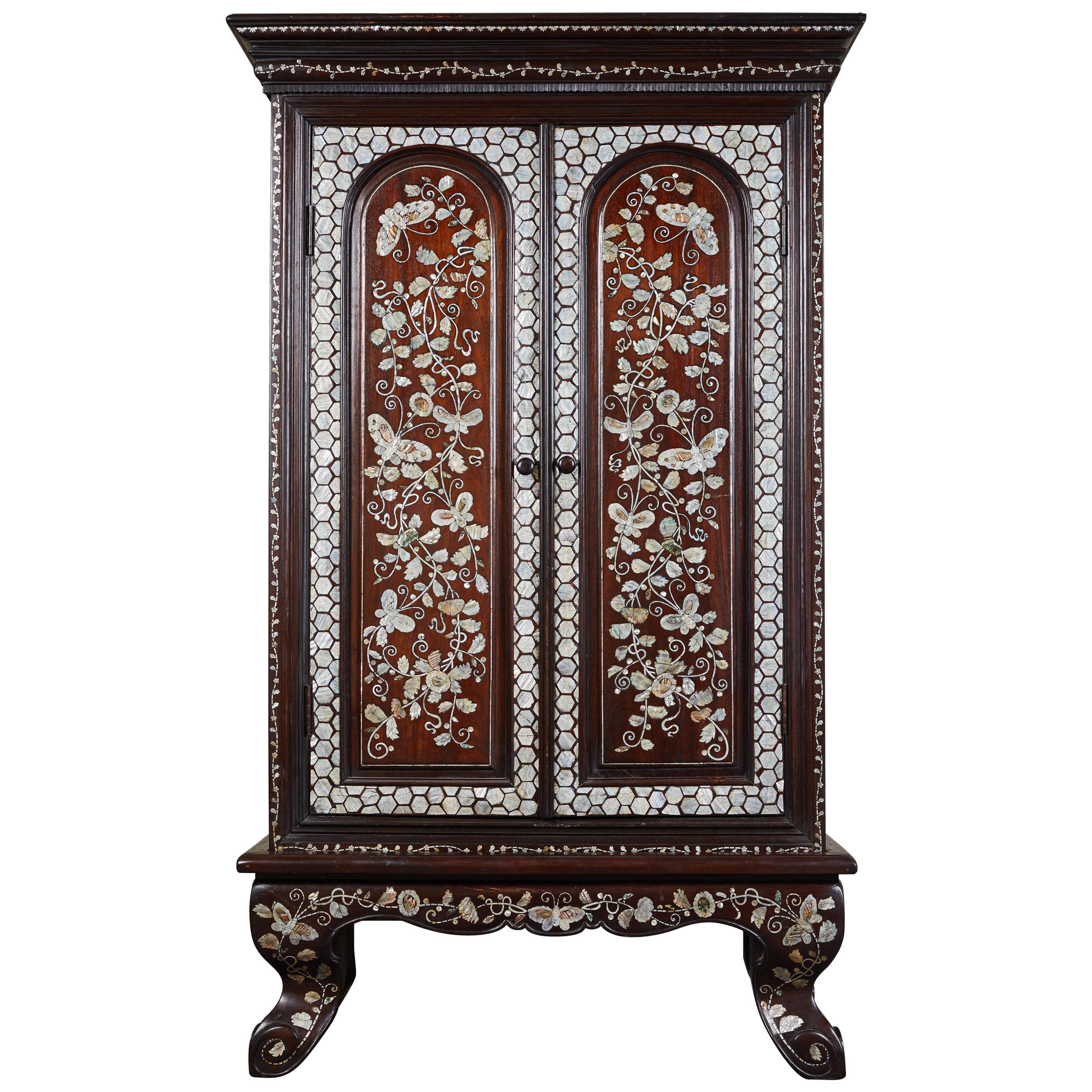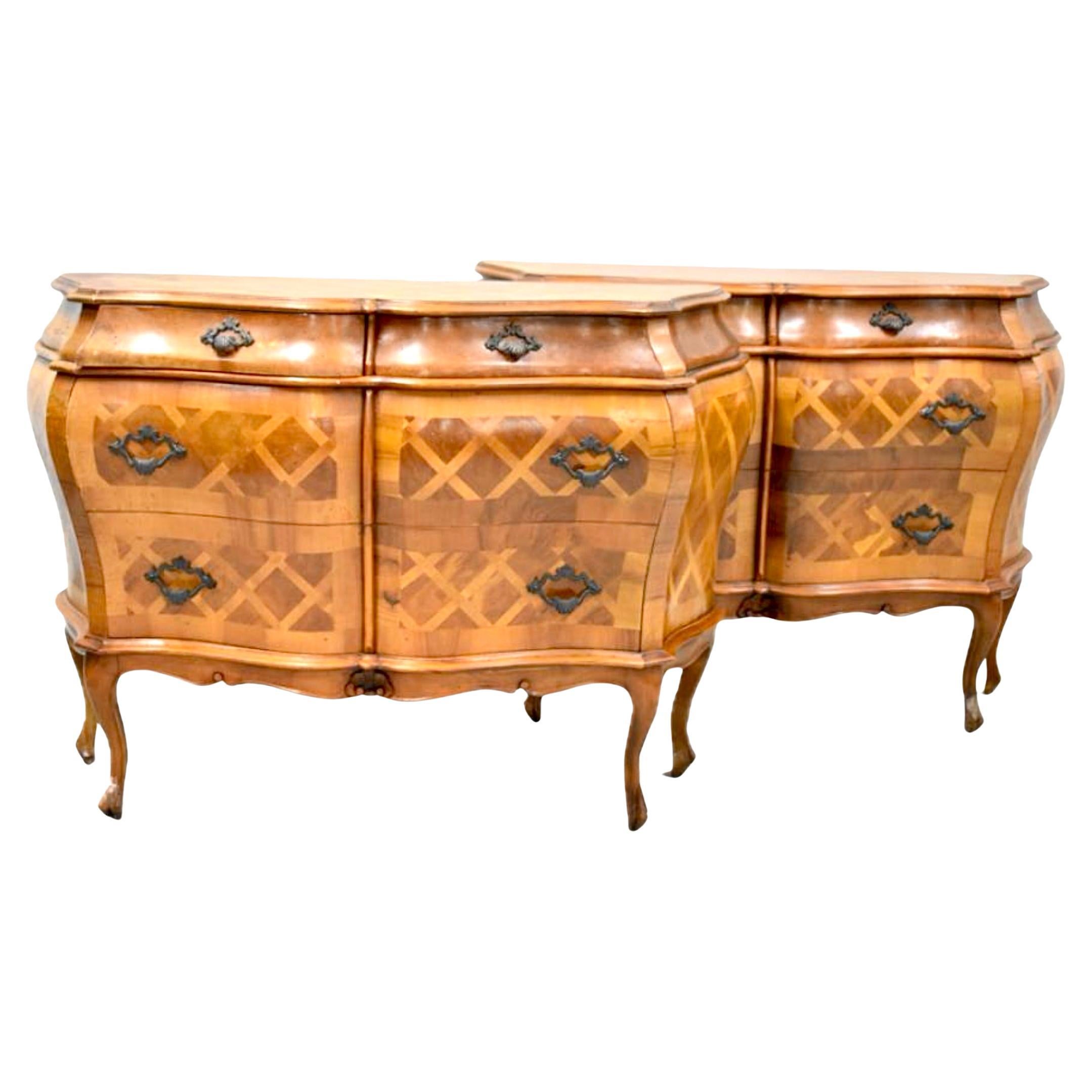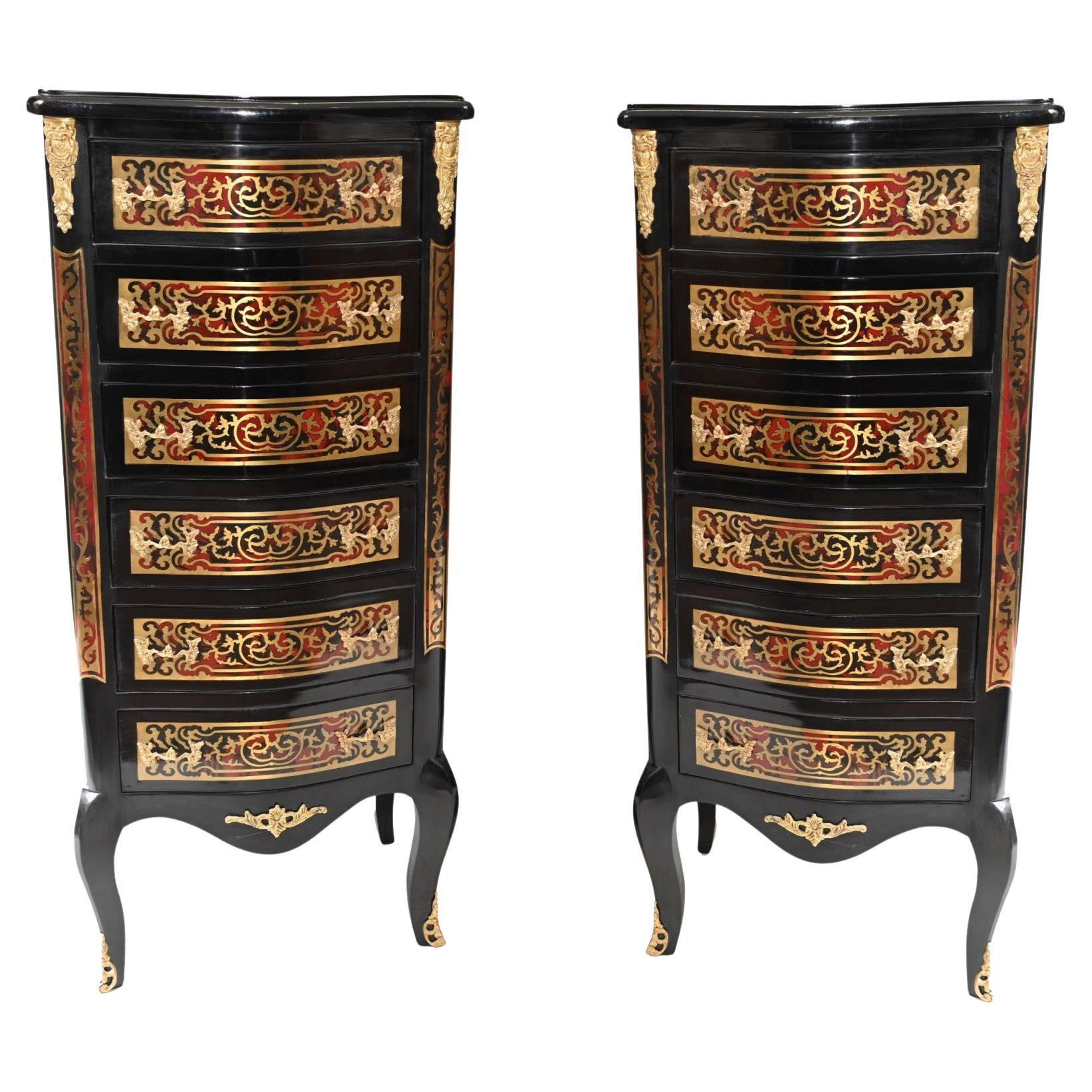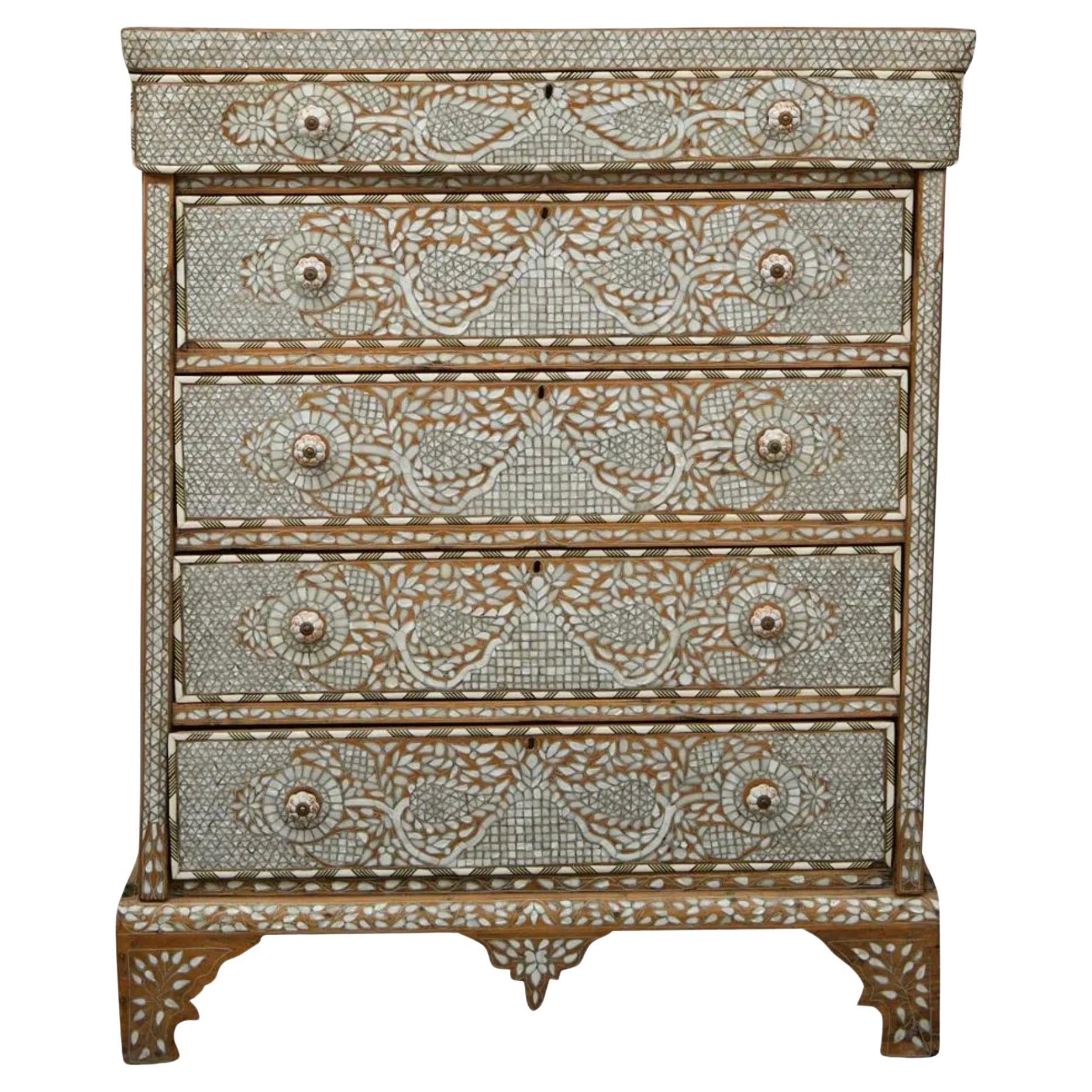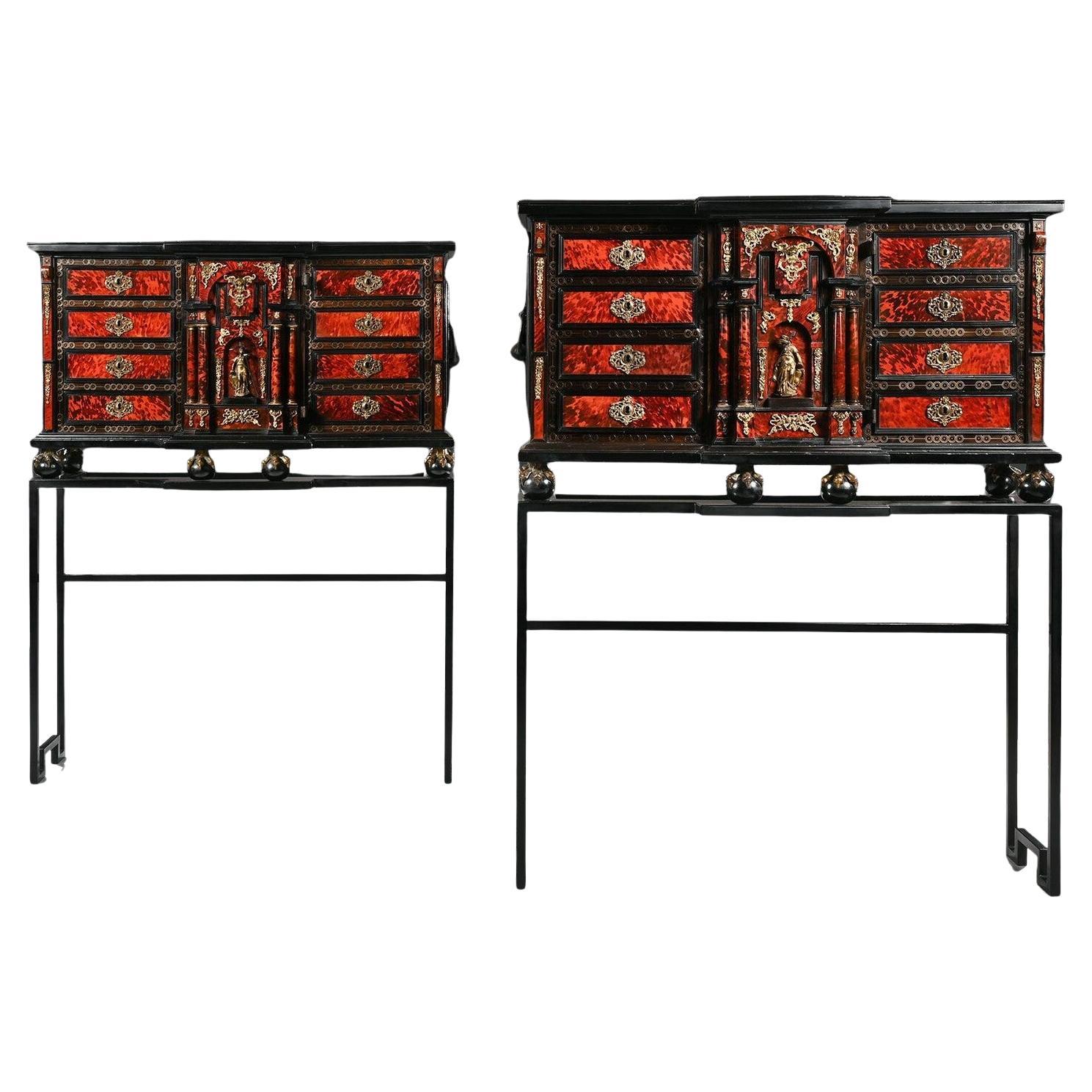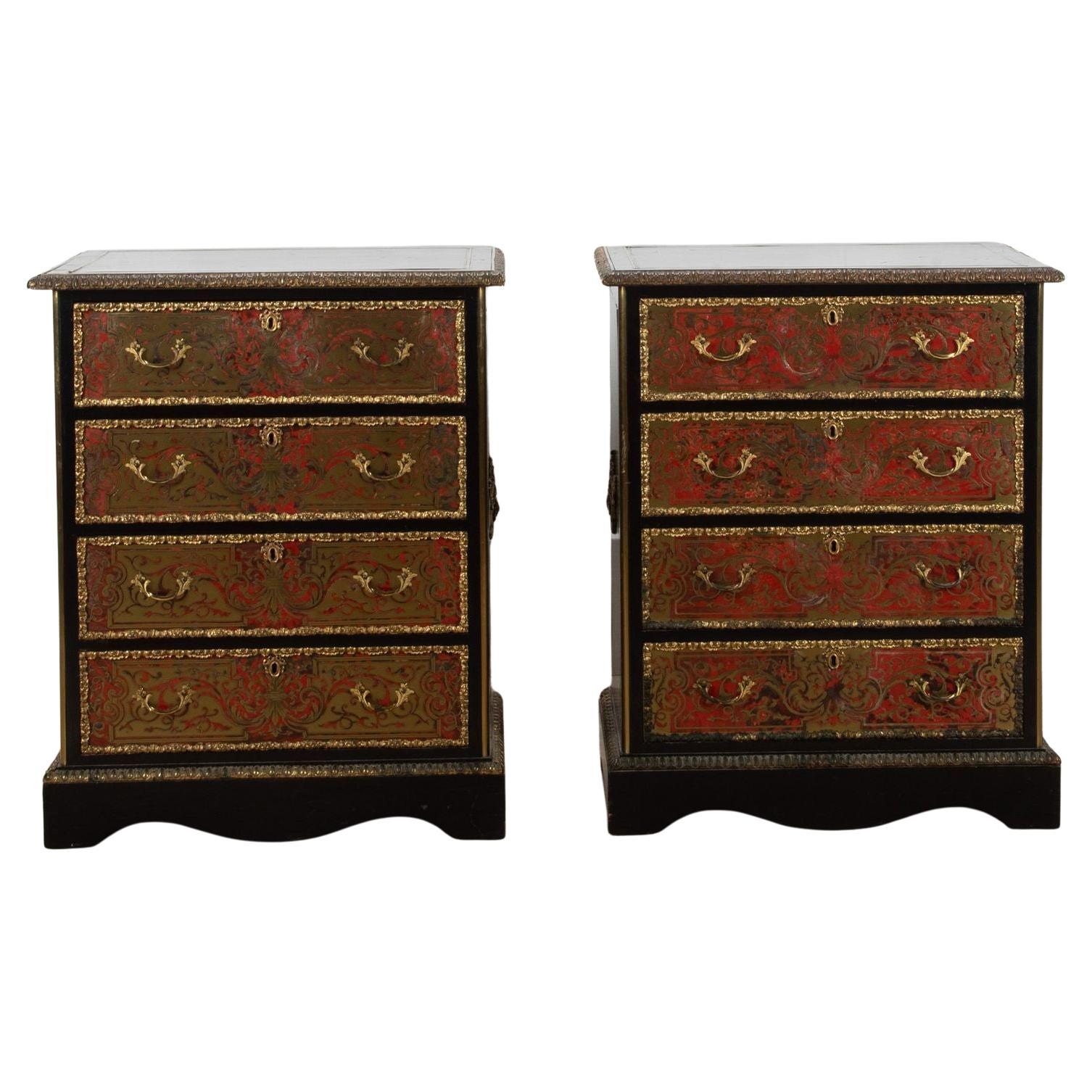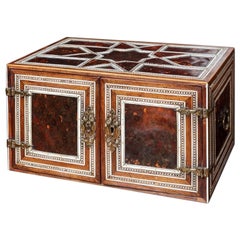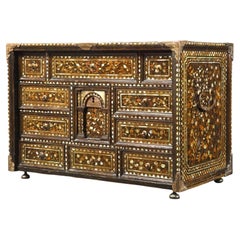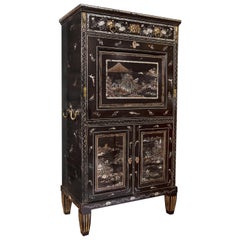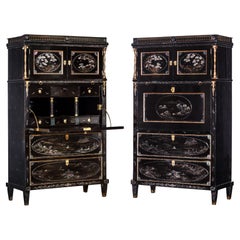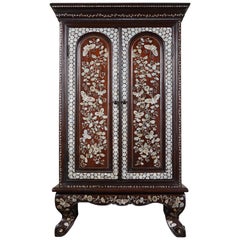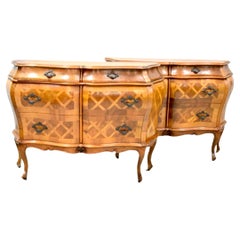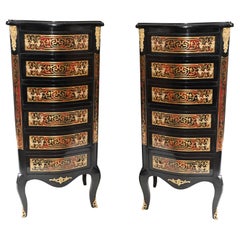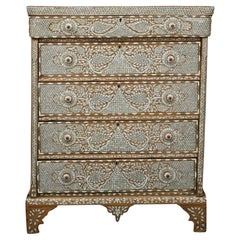Items Similar to A pair of Spanish-colonial Viceregal mother-of-pearl inlaid bureau-cabinets
Want more images or videos?
Request additional images or videos from the seller
1 of 11
A pair of Spanish-colonial Viceregal mother-of-pearl inlaid bureau-cabinets
$1,105,601.25
£827,570.18
€937,500
CA$1,521,622.42
A$1,696,006.69
CHF 889,836.53
MX$20,711,007.09
NOK 11,267,265.27
SEK 10,649,279.49
DKK 7,136,910.36
About the Item
Viceroyalty of Peru, Lima, 18th century, circa 1720-1760
Each with a moulded giltwood cornice and on a foliate carved giltwood base, possibly later and English. The cabinets, with silver mounts, are made of cedar, overall inlaid with mother-of-pearl. The interior is veneered with teak, American crabwood, Gele kabbes, and boxwood.
H. 213 x W. 115 x D. 52.5 cm (each)
Provenance:
Noble collection, United Kingdom; thence by descent
These spectacular bureau-cabinets are part of a fascinating production of decorative art and furniture from Lima, the affluent capital of the Spanish Vice-Royalty of Peru. Included are mother-of-pearl covered altarpieces, lecterns, caskets, boxes, tables, coffers, cabinets, and presumably the rarest: impressive bureaux such as the present pair. They are exquisite material examples of cultural cross-pollination in South and Central America, bridging multiple influences from Asia and Europe in a result that is both visually and historically impactful.
Indian, Korean, Chinese, Japanese and Arabian influence
This pair of cabinets is especially appealing for its shimmering surface of mother-of-pearl veneer, which was described as enconchado in inventories. It has as precursors the ‘Indo-Portuguese’ caskets, jugs and bowls, often silver mounted, produced in the Indian region of Gujarat in the 16th and early 17th centuries. These were shipped from Goa, the Portuguese colonial trade post on the west coast of India, to Portugal intended for the greatest monasteries, cathedrals and palaces of the country. Already in 16th century these lustrous Gujarati caskets, with nacre veneer fastened with silver nails in a fish-scale pattern were considered so precious in Europe that they were classified as jewellery in the inventories of royal collections and even nowadays they still are regarded as the most sought after works of art.
The Portuguese used the shimmering treasures from Gujarat as diplomatic gifts, which is how they ended up in the famous Habsburger kunstkammers of Vienna and Dresden. More important in this case are the reliquary caskets and other religious wares that ended up in collections of several Spanish monasteries and churches, as well as the games- boards and table-tops that were centrepieces in the homes of the most notable Spaniards.
With the establishment of more Portuguese trade routes within Asia, the Indian mother-of-pearl objects influenced the Japanese lacquer production. In large numbers the Portuguese ordered lacquerware for the purpose of being exported to Europe or big colonial cities like Spanish Manilla. The Spanish Manilla Galleon trade brought these objects to South America and, thus, to the Viceroyalty of Peru. It didn’t take long before there was a true rage for furniture decorated with nacre. However, the Portuguese controlled the market as they had monopolized access to the ports where the pieces could be ordered, such as Gujarat and Japan. Paying high prices, the Spaniards exported the goods to the Viceroyalties, where they enjoyed enormous popularity amongst the affluent class, particularly in Mexico and Peru. It wouldn’t be long before the Spanish brought Asian craftsmen to South America to produce these iridescent works of art themselves.
By the 18th century, the regular flow of the Manilla galleons from Manilla to Acapulco introduced an enormous quantity of Asian luxury items in both the Vice-Royalties of New Spain and Peru, with immediate and apparent influences on the local craftsmen and taste of the elites. The Asian influences in technique and motifs arrived from goods and through Asian craftsmen. Japanese and Chinese workers brought the techniques of inlaying materials (lacquer, a sort of gum or tree sap called mastic, wood, tortoiseshell, and much more) with mother-of-pearl. Arabs, who had to ‘convert’ to Christianism before they were allowed to immigrate, brought in Múdejar skills and their distinctive abstract approach to ornament without the imagery of animals or humans, as stated in the Quran. These cabinetmakers with all sorts of backgrounds in Mexico and Peru started to produce the finest inlaid and or veneered furniture and objects in the 17th and 18th centuries in their own style – each influenced by various available techniques and motifs. The most popular among the buyers would eventually become dominant.
Reflecting the syncretic nature of the present bureau- cabinets, the floral design of the mother-of-pearl veneers appears to have been inspired by ancient Korean designs from the Joseon or Chosõn Dynasty, seen in porcelain and objects with mother-of-pearl inlays on wood grounds. These designs are also seen in another Peruvian technique, which uses mother-of-pearl inlays on a tortoiseshell ground. However, most Far Eastern mother-of-pearl techniques find their origins in Korea.
- Dimensions:Height: 83.86 in (213 cm)Width: 45.28 in (115 cm)Depth: 83.86 in (213 cm)
- Style:Spanish Colonial (Of the Period)
- Materials and Techniques:
- Place of Origin:
- Period:
- Date of Manufacture:1720-1760
- Condition:Wear consistent with age and use.
- Seller Location:Amsterdam, NL
- Reference Number:1stDibs: LU5458239040402
About the Seller
5.0
Recognized Seller
These prestigious sellers are industry leaders and represent the highest echelon for item quality and design.
Established in 1985
1stDibs seller since 2020
23 sales on 1stDibs
Typical response time: 2 hours
- ShippingRetrieving quote...Shipping from: Amsterdam, Netherlands
- Return Policy
Authenticity Guarantee
In the unlikely event there’s an issue with an item’s authenticity, contact us within 1 year for a full refund. DetailsMoney-Back Guarantee
If your item is not as described, is damaged in transit, or does not arrive, contact us within 7 days for a full refund. Details24-Hour Cancellation
You have a 24-hour grace period in which to reconsider your purchase, with no questions asked.Vetted Professional Sellers
Our world-class sellers must adhere to strict standards for service and quality, maintaining the integrity of our listings.Price-Match Guarantee
If you find that a seller listed the same item for a lower price elsewhere, we’ll match it.Trusted Global Delivery
Our best-in-class carrier network provides specialized shipping options worldwide, including custom delivery.More From This Seller
View AllAn Indian colonial tortoiseshell veneered teak portable two-door cabinet
Located in Amsterdam, NL
Mughal India, Gujarat, 2nd half 17th century
H. 22.4 x W. 30.3 x D. 26.8 cm
This small cabinet has six drawers behind two doors. Originally ordered by the Portuguese, and made afte...
Category
Antique 17th Century Indian Antiquities
Materials
Tortoise Shell, Teak
Portuguese-colonial Japanese Namban lacquer Vargueno Cabinet, circa 1600
Located in Amsterdam, NL
A Portuguese-colonial Japanese Namban lacquer vargueno cabinet
Momoyama period, circa 1600
H. 43 x W. 64.5 x D. 36 cm
Wood, black lacquered and deco...
Category
Antique Early 1600s Japanese Antiquities
Materials
Gold, Brass
Japanese Export Lacquer Mother-of-Pearl Secretaire for the American Market
Located in Amsterdam, NL
A rare Japanese export lacquered secretaire for the American market
Circa 1800-1830, Colonial
Overall densely decorated with flower sprays and landscapes, minutely inlaid with ...
Category
Antique 1810s Japanese Edo Furniture
Materials
Mother-of-Pearl, Wood
A fine pair of Japanese export lacquer secretaires owned by Sir Stamford Raffles
Located in Amsterdam, NL
'The Stamford Raffles Secretaires.'
A pair of Japanese Kyoto-Nagasaki style export lacquer secretaires by ‘Lakwerker Sasaya’ each with the name ‘Ol...
Category
Antique Early 19th Century Japanese Secretaires
Materials
Gold, Brass
$813,722 / set
Free Shipping
A Dutch-colonial Sri Lankan nedun wood and Indian padouk miniature chiffonier
Located in Amsterdam, NL
Apart from being a highly decorative object and a status symbol, these miniature pieces of furniture also functioned as collector’s items. Just like the dollhouses were for rich wome...
Category
Antique 18th Century Sri Lankan Dutch Colonial Furniture
Materials
Silver
16th-Century Indo-Portuguese Colonial Mother-of-pearl Gujarat Casket
Located in Amsterdam, NL
An exceptional Indo-Portuguese colonial mother-of-pearl veneered casket with silver mounts
India, Gujarat, 2nd half of the 16th century, the silver mounts Goa or probably Lisbon
Measures: H. 16 x W. 24.6 x D. 16.1 cm
An exceptional Gujarati casket with a rectangular box and truncated pyramidal lid (with slopes on each side and a flat top) made from exotic wood, probably teak (Tectona grandis), covered with a mother-of-pearl mosaic. The tesserae, cut from the shell of the green turban sea snail (Turbo marmoratus, a marine gastropod) in the shape of fish scales, are pinned to the wooden structure with silver ball-headed nails. The casket is set on bracket feet on the corners. The masterfully engraved decoration of the silver mounts follows the most refined and erudite Mannerist repertoire of rinceaux and ferroneries dating from the mid-16th century. The high quality and refinement of the silver mounts and, likewise, the silver nails that replaced the original brass pins used to hold the mother-of-pearl tesserae in place indicate the work of a silversmith probably working in Lisbon in the second half of the 16th century.
The Indian origin of this production, namely from Cambay (Khambhat) and Surat in the present state of Gujarat in north India, is, as for the last three decades, consensual and fully demonstrated, not only by documentary and literary evidence - such as descriptions, travelogues and contemporary archival documentation - but also by the survival in situ of 16th-century wooden structures covered in mother-of-pearl tesserae. A fine example is a canopy decorating the tomb (dargah) of the Sufi saint, Sheik Salim Chisti (1478-1572) in Fatehpur Sikri in Agra district in the state of Uttar Pradesh, north India. This is an artistic production, geometric in character and Islamic in nature, where usually the mother-of-pearl tesserae form complex designs of fish scales or, similar to the dishes also made using the same technique, with the thin brass sheets and pins, stylized lotus flowers. The truncated pyramidal shape corresponds, like their contemporary tortoiseshell counterparts also made in Gujarat, to a piece of furniture used in the Indian subcontinent within the Islamic world prior to the arrival of the first Portuguese. This shape, in fact, is very old and peculiar to East-Asian caskets, chests or boxes used to contain and protect Buddhist texts, the sutras.
A similar chest is the famous and large reliquary chest from Lisbon cathedral that once contained the relics of the city's patron saint, Saint Vincent. Both match in shape, having the same kind of socle or pedestal and bracket feet, and in their engraved silver mountings, featuring the same type of refined, erudite decoration. Their differences lie in the silver borders that frame the entire length of the edges of the chest (both the box and the lid), pinned with silver nails, and on the lock plate, shaped like a coat of arms in the Lisbon example. Given the exceptional dimensions of the reliquary casket...
Category
Antique 16th Century Indian Jewelry Boxes
Materials
Silver
You May Also Like
19th Century French Colonial Cabinet with Mother of Pearl
Located in San Marino, CA
19th century French colonial cabinet with mother-of-pearl inlay along all panels. Hexagonal mosaic along door trim, with floral and butterfly motif throughou...
Category
Antique 19th Century Vietnamese Colonial Revival Cabinets
Pair of Italian Bombay Inlaid Chests
Located in Bradenton, FL
Beautiful pair of walnut Italian Bombe Chests. Chests feature a shaped top with a curved bombe shape adding a sense of elegance and fluidity. Chests contain four drawers with parquet...
Category
Mid-20th Century Italian Baroque Commodes and Chests of Drawers
Materials
Wood, Walnut
$5,600 / set
Pair Boulle Chest of Drawers Tall Boy French Inlay
Located in Potters Bar, GB
Gorgeous single French Boulle style chest of drawers
Boulle was a famous French cabinet maker working out of Paris in the 1800s
Boulle was reknowned for his distinctive style of inla...
Category
Vintage 1980s French Provincial Cabinets
Materials
Wood
Syrian Mother of Pearl Inlaid Chest of Drawers
Located in Dallas, TX
Syrian mother of pearl inlaid wooden chest of drawers. With five drawers. The wood is profusely decorated throughout with mother of pearl and shell in intricate floral and geometric ...
Category
20th Century Commodes and Chests of Drawers
Materials
Mother-of-Pearl, Wood
Pair of 17th Century Spanish Baroque Gilt Bronze Mounted Cabinets on Stands
Located in Benington, Herts
An Exceptional and rare pair of 17th Century Spanish Baroque gilt bronze and metal mounted ebonised and tortoiseshell cabine...
Category
Antique Late 17th Century Spanish Baroque Cabinets
Materials
Tortoise Shell, Ebony
Pair of 19th Century French Boulle Tortoiseshell Commodes
Located in Gloucestershire, GB
An exceptionally rare pair of small late 19th Century French boulle commodes.
The fronts with impressive premier-partie and contre-partie brass and tortoiseshell inlays.
With finely ...
Category
Antique Late 19th Century French Napoleon III Commodes and Chests of Dra...
Materials
Brass
More Ways To Browse
Spanish Ship
Colonial Kitchen
Antique Bureau Cabinet
Colonial India
Colonial Spanish Art
Spanish China
Mexican Colonial
Antique Carved Mother Of Pearl
Antique Silver Storage Cabinet
Chinese Workers
Spanish Carved Cabinet
Mother Of Pearl Inlay Table
Antique Jewelry Cabinet
Pair Of China Cabinets
Mother Of Pearl Inlay Jewellery
Mexican Colonial Furniture
Large Bureau
Spanish Carved Storage Cabinets
